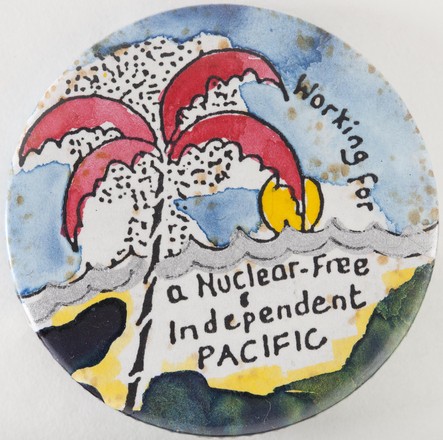Protest badges for peace and nuclear disarmament, 1960s – 1980s
Metal
and plastic
R
858 / 1–16
Show your allegiance, display solidarity, campaign for
change, protest injustice or express what matters to you. Wear a badge and
participate in democracy ... Opposition to the use of nuclear weapons,
nuclear energy and nuclear testing is chronicled on a large number of badges,
with evocative slogans such as ‘Children need smiles not missiles’, ‘Arms are
for linking’ and ‘Hiroshima Never Again’, a reference to the bombing
of the Japanese cities of Hiroshima and Nagasaki by the United States in August
1945.
The
button badge is regarded as one of the first promotional products to be used in
Australia.
www.patricksmarketing.com.au/history
By their very nature badges are pithy, condensed and
catchy, intended to convey their message in a snappy phrase or iconic symbol.
Aside from the clever, blunt, declarative language used on political badges,
many of them rely on strong images to convey their meaning.
Steven Murkett, 'I am an enemy of the state ...', Museum of Australian Democracy blog, 28 November 2012
B.A.M. (Badge-A-Minit) is the acronym for a
semi-automatic button badge making machine. The acronym is impressed into the plastic insert at the rear of two of the button badges on display: 'Keep the Pacific nuclear-free' and 'Children need smiles not missiles'.
A
button badge consists of several layers (from rear to face): the metal pinback,
the metal shell; the artwork on a thin substrate such as paper; and a plastic film such as mylar.
They are layered over each other then pressed together under pressure with
shell being rounded over edges of pinback.
In the
1800s, the Patrick Family began a photo medallion and picture framing business
in Redfern, Sydney. Some years later the business expanded to include the
manufacture and sale of button badges in King Street, Newtown, Sydney …
Mobilise for survival – Stop nuclear madness,
Patrick Bros., Melbourne
Uranium? No thanks, 1974–1980
Patricks
developed badges for charity fund raising promotions and was a key figure in
the fund raising effort for the First World War. These badges helped raise more
than $50 million …
Together we can stop the bomb, Nuclear
Disarmament Lobby, 1960–1981



 Back to list
Back to list